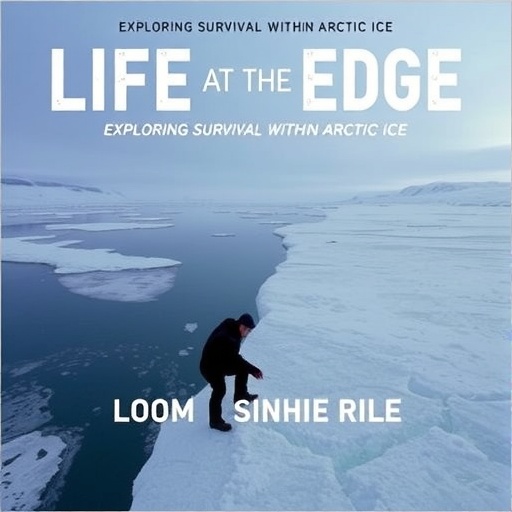Deep beneath the Arctic ice, microscopic organisms are rewriting what we thought possible for life in extreme environments. Recent groundbreaking research from Stanford University has uncovered that Arctic diatoms, single-celled algae encased in glass-like walls, are not just passively surviving the frigid conditions but actively gliding through channels in frozen ice at unprecedented low temperatures. These astonishing findings, published in the prestigious Proceedings of the National Academy of Sciences, push the boundaries of cellular motility, revealing complex eukaryotic life persisting and moving at temperatures as low as -15 degrees Celsius (5 degrees Fahrenheit).
Diatoms—renowned for their intricate silica shells—have long been known to inhabit polar ice, though until now they were considered dormant or trapped. However, this new study challenges that narrative, showing that these tiny algae exhibit remarkable mobility deep within the Arctic ice pack. By using novel, custom-developed microscopes capable of imaging organisms inside ice cores at subzero temperatures, researchers have captured diatoms gliding in a smooth, uninterrupted motion, akin to skating on natural frozen highways formed within the ice. This is a striking revelation because motility in complex cells at such subzero temperatures was previously thought to be impossible.
The study began with an ambitious 45-day expedition in the Chukchi Sea aboard the research vessel Sikuliaq, where scientists from the Prakash Lab and collaborators harvested ice cores from a dozen distinct Arctic locations throughout the 2023 summer. These cores revealed thin layers of ice housing crystalline freshwater channels surrounded by salted frozen water. By replicating these unique microenvironments in laboratory conditions, the team observed that diatoms could traverse these narrow, hair-thin pathways without the typical appendages associated with cellular movement. Instead, the diatoms employed a specialized gliding mechanism that relies on secreted mucus and motor proteins.
This form of motility derives from the secretion of a polymer mucilage, reminiscent of snail mucus, which adheres to the icy substrate like an anchored rope. The diatoms then pull themselves forward by contracting actin and myosin fibers—molecular motors highly conserved across eukaryotic species and responsible for human muscle contractions. This biological machinery operating effectively at temperatures well below freezing opens new avenues for understanding how cellular components adapt to extreme cold, potentially involving previously unknown biochemical or structural modifications that preserve motor functionality.
Lead author Qing Zhang, a postdoctoral scholar at Stanford, emphasizes that this gliding motion occurs without the customary wiggling or crawling typical of microorganisms, making it an energy-efficient strategy perfectly suited for the harsh polar environment. The observed speeds of the Arctic diatoms exceeded those of related species from temperate climates crawling on glass surfaces, signifying an evolutionary advantage honed for survival in icy realms. Such remarkable motility at record-low temperatures redefines the physiological limits of eukaryotes, with implications for ecology, cellular biology, and even astrobiology.
Beyond the biological marvel, this discovery holds significant ecological implications. The Arctic ice, long perceived as a barren white expanse, conceals a bustling microbial ecosystem beneath its surface. Diatoms contribute to this hidden “green” world, serving as crucial components of the polar food web. Their gliding activities may facilitate nutrient redistribution, creating biological hotspots that support higher trophic levels, from minute invertebrates to polar bears. This dynamic challenges the presumption that polar ice is purely an ecological dead zone during colder months.
Moreover, the secretion of mucilage and its subsequent trails on the ice open speculative yet compelling questions. Could these mucus networks act as nucleation sites for new ice formation, much like how pearls form around microscopic impurities? The possibility that diatom activity directly influences cryogenic processes adds a fascinating biophysical dimension to our understanding of polar ice dynamics and ecosystem engineering.
The team employed innovative microfluidic experiments, embedding fluorescent beads in gelatin-like gels to visualize and quantify diatom movements meticulously. This inventive approach allowed them to track the footprints left by gliding diatoms, providing concrete evidence of their locomotion patterns under tightly controlled temperatures. Their custom subzero microscopy technology—pioneered within the Prakash Lab—proved essential for these revelations, enabling safe observation of living cells in conditions mirroring their natural cryo-habitats with unprecedented spatial and temporal resolution.
This research also carries a sobering message amid climate change concerns. Principal investigator Manu Prakash highlights the urgency of preserving Arctic scientific infrastructure, especially in light of looming funding cuts to polar research by the U.S. National Science Foundation. As warming threatens to melt the Arctic ice cap within decades, not only is a unique biome at risk, but with it valuable knowledge about branches of the tree of life that have adapted to survive at nature’s coldest frontiers. Protecting the ability to conduct in situ polar research remains critical to unlocking these mysteries before they vanish.
The endeavor was a true interdisciplinary triumph, integrating bioengineering, earth system science, microbial ecology, and advanced imaging technologies. Kevin Arrigo, a co-author and earth system science professor, contributed expertise on polar ecosystems, bridging biological data with environmental processes. Together, the team’s collaborative spirit and innovative methodology have illuminated an invisible world previously beyond scientific reach.
This discovery of ice-gliding diatoms breaking new ground in the limits of eukaryotic motility reshapes our understanding of life’s resilience. It challenges long-standing assumptions about the freezing point of cellular activity and invites a reevaluation of extreme ecology on Earth. Beyond academic curiosity, it may inspire biomimetic designs for cold-environment robotics or cryopreservation techniques. As the Arctic continues to transform, these microscopic pioneers skate on the very edge of survival, silently scripting a story of adaptation that captivates science and society alike.
Subject of Research: Arctic diatoms’ motility at subzero temperatures inside ice cores
Article Title: Ice gliding diatoms establish record-low temperature limits for motility in a eukaryotic cell
News Publication Date: 9-Sep-2025
Web References:
References: Proceedings of the National Academy of Sciences, Volume and Issue from Sept 2025 issue
Image Credits: Prakash Lab
Keywords: Algae, Cell biology, Cellular physiology, Extremophiles, Microorganisms, Arctic ice, Polar ice caps, Ecology




